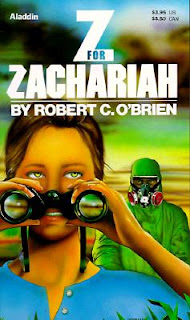O'Brien Read/Watch: Z for Zachariah
Z for Zachariah is Robert C. O'Brien's last novel, published posthumously by his wife and daughter (after they completed it based on his notes). Despite the fact that O'Brien's family finished the book for him, the style remains consistent throughout -- though I wouldn't necessarily say it's O'Brien's style. The reason for that is this: in the three novels of his that I've read so far, he maintains a different voice in each. Mrs. Frisby has its omniscient narrator peeking into the minds of animals, The Silver Crown's narrator is more limited, sticking almost entirely to Ellen's perspective, and Z for Zachariah is written in first person as journal entries of the main character, Ann Burden.
Set in an undefined future (from the perspective of the '70s), Z for Zachariah follows Ann Burden's account of how she survives following a nuclear and biological war in her native valley. Ann's peaceful if isolated life is immediately (from the reader's perspective) interrupted by the appearance of a stranger in a biohazard suit. This person is the first living human Ann has seen since her family left in search of life outside the valley, never to return. Not knowing the nature of this stranger, and despite her longing for human interaction, Ann hides all traces of her existence in order to observe the stranger. After determining the stranger to be friendly (or at least benign), Ann introduces herself. The stranger reveals himself to be a man named Loomis, a scientist who worked on a project to create the suit and apparatus he has used to travel from his military base to Ann's valley. The suit is the only one of its kind, due to the war having broken out before the project moved beyond the prototype stage.
Unfortunately, Loomis makes a mistake shortly after arriving in the valley, before Ann reveals herself. He bathes in the polluted river (there are two in the valley -- a clean one whose source is inside the valley, and the polluted one that flows in from outside) and consequently succumbs to radiation sickness. Ann nurses him through, and when he is recovered they begin to plan for the long-term survival of the valley. As Loomis regains more of his former strength, however, Ann discerns his true character. He is domineering, narcissistic, and manipulative. He attempts to control Ann's behavior over the course of weeks, culminating in a (failed) attempt to force himself on her. Ann escapes, and Loomis' attempts to control her escalate further. He locks the town store where the supplies of nonperishable food are, withholds the key to the tractor so Ann cannot maintain the crops, and even attempts to maim her so she cannot run from him again.
Eventually, Ann confronts Loomis head-on, after tricking him into leaving the biohazard suit unguarded. She steals the suit and the rest of the supplies she will need and makes it clear that Loomis' only options are allow her to leave or shoot her, damaging the suit. The novel ends with Ann exploring the world beyond the valley in pursuit of a populated place she has seen only in her dreams.
Z for Zachariah caught me off-guard. Although I knew this was one of O'Brien's novels aimed at adults (despite it reminding me of many middle grade and YA novels from my elementary and middle school years), I didn't expect it to carry such a heavy weight of fear and anxiety throughout. Loomis' first appearance sets the stage. Ann wants to greet him, but hides because she does not know he can be trusted. As the book progresses, her feelings toward Loomis remain ambivalent. She will feel affection or kindness toward him only for him to reveal a darker part of himself -- sometimes through information about his past, sometimes in the way he dismisses Ann as young and stupid, sometimes in aggressive behavior. Loomis' personality is gradually revealed as that of a controlling abuser, one who attempts to placate his victim into returning to the relationship, one who minimizes his own actions rather than admitting fault. While the book's themes surprised me, what surprises me more is that this book is not taught in schools. These are themes that are rarely handled this well in fiction. (Knowing O'Brien's family finished the book, I have to wonder how much of this aspect came from him and how much from them; in any event, the novel is successful in its portrayal of such relationships.)
My one real disappointment with the novel is that its ending just . . . ends. After a lengthy build-up to the realization that only one of them will survive their last encounter, Loomis lets Ann walk away and Ann does not shoot Loomis, even in self-defense. While violence shouldn't be condoned, the final scenes fell flat for me precisely because the tension simply dissolves. Ann's triumph over Loomis feels less substantial than it might have otherwise because he gives up. Yes, she finally outsmarts him, but his decision to let Ann leave does not match his previous characterization. (Again, I wonder how much of this is O'Brien and how much is his family.)
As a side note, all three of O'Brien's novels so far have featured crows in some significant way (Jeremy in NIMH, Richard in Silver Crown, and the family of crows in the church in Z). If A Report from Group 17 does not have crows, I will be disappointed, as I'm beginning to think of them as O'Brien's trademark.
Tune in soon for a review of the 2015 film adaptation of Z for Zachariah.
Have you read Z for Zachariah? What were your thoughts on it? Let me know in the comments!
Set in an undefined future (from the perspective of the '70s), Z for Zachariah follows Ann Burden's account of how she survives following a nuclear and biological war in her native valley. Ann's peaceful if isolated life is immediately (from the reader's perspective) interrupted by the appearance of a stranger in a biohazard suit. This person is the first living human Ann has seen since her family left in search of life outside the valley, never to return. Not knowing the nature of this stranger, and despite her longing for human interaction, Ann hides all traces of her existence in order to observe the stranger. After determining the stranger to be friendly (or at least benign), Ann introduces herself. The stranger reveals himself to be a man named Loomis, a scientist who worked on a project to create the suit and apparatus he has used to travel from his military base to Ann's valley. The suit is the only one of its kind, due to the war having broken out before the project moved beyond the prototype stage.
Unfortunately, Loomis makes a mistake shortly after arriving in the valley, before Ann reveals herself. He bathes in the polluted river (there are two in the valley -- a clean one whose source is inside the valley, and the polluted one that flows in from outside) and consequently succumbs to radiation sickness. Ann nurses him through, and when he is recovered they begin to plan for the long-term survival of the valley. As Loomis regains more of his former strength, however, Ann discerns his true character. He is domineering, narcissistic, and manipulative. He attempts to control Ann's behavior over the course of weeks, culminating in a (failed) attempt to force himself on her. Ann escapes, and Loomis' attempts to control her escalate further. He locks the town store where the supplies of nonperishable food are, withholds the key to the tractor so Ann cannot maintain the crops, and even attempts to maim her so she cannot run from him again.
Eventually, Ann confronts Loomis head-on, after tricking him into leaving the biohazard suit unguarded. She steals the suit and the rest of the supplies she will need and makes it clear that Loomis' only options are allow her to leave or shoot her, damaging the suit. The novel ends with Ann exploring the world beyond the valley in pursuit of a populated place she has seen only in her dreams.
Z for Zachariah caught me off-guard. Although I knew this was one of O'Brien's novels aimed at adults (despite it reminding me of many middle grade and YA novels from my elementary and middle school years), I didn't expect it to carry such a heavy weight of fear and anxiety throughout. Loomis' first appearance sets the stage. Ann wants to greet him, but hides because she does not know he can be trusted. As the book progresses, her feelings toward Loomis remain ambivalent. She will feel affection or kindness toward him only for him to reveal a darker part of himself -- sometimes through information about his past, sometimes in the way he dismisses Ann as young and stupid, sometimes in aggressive behavior. Loomis' personality is gradually revealed as that of a controlling abuser, one who attempts to placate his victim into returning to the relationship, one who minimizes his own actions rather than admitting fault. While the book's themes surprised me, what surprises me more is that this book is not taught in schools. These are themes that are rarely handled this well in fiction. (Knowing O'Brien's family finished the book, I have to wonder how much of this aspect came from him and how much from them; in any event, the novel is successful in its portrayal of such relationships.)
My one real disappointment with the novel is that its ending just . . . ends. After a lengthy build-up to the realization that only one of them will survive their last encounter, Loomis lets Ann walk away and Ann does not shoot Loomis, even in self-defense. While violence shouldn't be condoned, the final scenes fell flat for me precisely because the tension simply dissolves. Ann's triumph over Loomis feels less substantial than it might have otherwise because he gives up. Yes, she finally outsmarts him, but his decision to let Ann leave does not match his previous characterization. (Again, I wonder how much of this is O'Brien and how much is his family.)
As a side note, all three of O'Brien's novels so far have featured crows in some significant way (Jeremy in NIMH, Richard in Silver Crown, and the family of crows in the church in Z). If A Report from Group 17 does not have crows, I will be disappointed, as I'm beginning to think of them as O'Brien's trademark.
Tune in soon for a review of the 2015 film adaptation of Z for Zachariah.
Have you read Z for Zachariah? What were your thoughts on it? Let me know in the comments!




Comments
Post a Comment
What do you think?